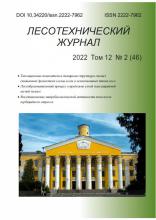Voronezh, Voronezh, Russian Federation
The problem of afforestation of zonal humus-calcareous soils with close occurrence of chalk rocks has been considered. The research results of reclamation plantations on zonal humus-carbonate soils (Voronezh region, Ostrogozhsky district, Korotoyaksky district forestry) are presented. The main taxation indicators of silver birch (Betula pendula), English oak (Quercus robur), Scots pine (Pinus sylvestris), such as average height and diameter, bonitet, density, preservation, stock, increase in stock, have been found. The characteristics of the current state and productivity of protective plantations are given. The course of growth and the state of Scots pine plantations on humus-carbonate soils depends on the depth of the chalk rocks. Less demanding tree species for soil and soil conditions, such as Betula pendula, Pinus sylvestris, have higher growth rates than more demanding species. It is possible to grow Pinus sylvestris plantations on humus-carbonate soils with a thickness of 40-50 cm - I bonitet; 30-40 cm - II bonitet; 15-20 cm - II - III bonitet. The influence of slabby chalk depth on the coefficient of growth stress is at least 90% of the total amount of influencing factors. With an increase in the thickness of the humus-carbonate layer from 15 - 20 cm to 40 - 50 cm, the growth stress coefficient decreases 2.4-2.5 times. It is not recommended to create plantations with 1.0 × 0.5 m planting points (15-20 thousand units/ha). Such plantations have a very high growth stress coefficient and are biologically weakened
forest plantations, humus-carbonate soil, course of growth, bonitet, stock, safety, reforestation, chalk outcrops
1. Dedenko, T.P. Antropogenno-melovye landshafty CChR i ih optimizaciya dlya lesnoy rekul'tivacii: monogr. / T.P. Dedenko ; M-vo nauki i vysshego obrazovaniya RF, FGBOU VO «VGLTU». - Voronezh, 2019. - 166 S. EDN: https://elibrary.ru/MUQEYZ
2. Dedenko, T.P. Osobennosti rosta i sostoyaniya kul'tur sosny pri lesovosstanovlenii na peregnoyno-karbonatnyh pochvah CChO / T.P. Dedenko // Lesa Rossii: politika, promyshlennost', nauka, obrazovanie. Materialy tret'ey mezhdunarodnoy nauchno-tehnicheskoy konferencii. Tom 1 /Pod. red. V.M. Ged'o. - SPb.: SPbGLTU, 2018. - s.100-103. EDN: https://elibrary.ru/XRQBRR
3. Dudarev, A.D.. Metodika i tehnika rabot na probnyh ploschadyah / A.D. Dudarev, N.V. Gladyshev, A.D. Lozovoy // Voronezh, 1978 - 80 s. EDN: https://elibrary.ru/YKEUOH
4. Isachenko, A. G. Ekologicheskaya geografiya Rossii / A. G. Isachenko. - SPb.: Izd-vo SPb. un-ta. 2001. 328 s.
5. Chernodubov, A.I. Sovremennoe sostoyanie «melovyh» borov / A. I. Chernodubov // Lesovedenie. - 1992. №6. - S.78-81. EDN: https://elibrary.ru/RUMNJD
6. Shul'ga, V. D. Vliyanie izmeneniya vodnogo rezhima pochv na sostoyanie glavnyh porod v poymennyh lesah, v zaschitnyh lesnyh nasazhdeniyah, na arenah i v polezaschitnyh lesnyh polosah aridnoy zony / V. D. Shul'ga // Vestnik Central'no-Chernozemnogo regional'nogo otdeleniya nauk o lese RAEN i VGLTA. - Voronezh, 2002. - Vyp. 4,ch. 1.- S. 149-159.
7. Mil'kov, F. N. Fizicheskaya geografiya: uchenie o landshafte i geograficheskaya zonal'nost' / F. N. Mil'kov. - Voronezh: Izd-vo Voronezh. Gos. un-ta, 1986. - 328 s.
8. Mihno, V. B. Osnovy fiziko-geograficheskogo rayonirovaniya: ucheb. posobie / V. B. Mihno; Voronezh. gos. un-t. - Voronezh: Izd-vo Voronezh. gos. un-ta, 2005. - 280 s. EDN: https://elibrary.ru/QKFKZX
9. Doddabasawa. Traditional agroforestry systems and biodiversity conservation / Doddabasawa, B.M. Chittapur, M.M. Murthy // Bangladesh Journal of Botany/ - 2018. - Vol.47(4). - P.927-930.
10. Forest restoration following surface mining disturbance:challenges and solutions / S.E. Macdonald [et al.] // New Forest. - 2015. -Vol.46, Issue 5-6. - P. 703-732. DOI: https://doi.org/10.1007/s11056-015-9506-4; EDN: https://elibrary.ru/AMPVNR
11. Santos, P.Z.F. Can agroforestry systems enhance biodiversity and ecosystem service provision in agroculture Landscapes meta-analysis for the Brazilian Atlantic Forest / P. Z. F. Santos, R. Crouzeilles, J. B.B. Sansevero // Forest Ecology and Management. - 2019. - Vol. 433.- P. 140-145












